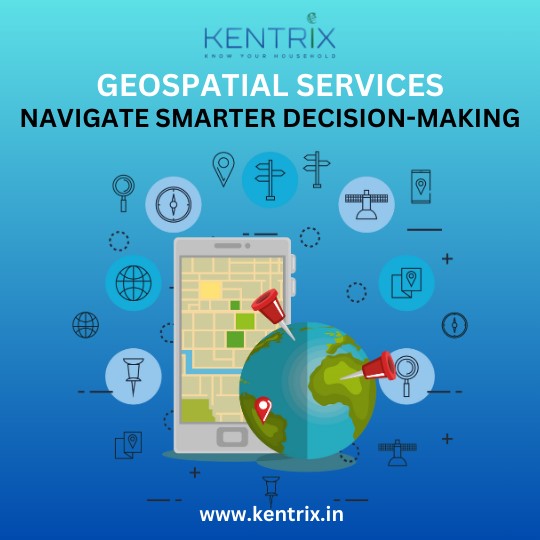In today’s data-centric world, businesses are increasingly turning to geospatial services to enhance operational efficiency and support strategic decision-making. Geospatial services involve the collection, analysis, and visualization of geographic data, providing organizations with crucial insights into market dynamics, customer behavior, and resource allocation.
Kentrix, a leader in consumer intelligence solutions, offers innovative tools designed to harness the power of geospatial data, enabling companies to navigate complexities effectively.
This article delves into the significance of geospatial services in business and highlights the tools and solutions provided by Kentrix.
Understanding Geospatial Services
Geospatial services encompass a wide range of activities that utilize Geographic Information Systems (GIS) and location-based data analysis. GIS technology allows businesses to capture, store, analyze, and manage spatial or geographic data.
By integrating geospatial data with traditional business analytics, companies can achieve a more comprehensive understanding of their market environment. This integration helps businesses visualize patterns and trends that conventional analysis methods may overlook.
Key Components of Geospatial Services
- Data Collection: This involves gathering geographic data from various sources, including satellite imagery, GPS systems, surveys, and existing databases.
- Data Analysis: Once collected, the data is analyzed to identify trends, correlations, and patterns that can inform business decisions.
- Visualization: The results of the analysis are often presented in visual formats such as maps, charts, and graphs. This makes it easier for stakeholders to understand complex information at a glance.
- Decision Support: The ultimate goal of geospatial services is to support decision-making processes by providing actionable insights based on geographic information.
The Importance of Geospatial Data in Business
Enhanced Decision-Making
Geospatial data provides valuable insights that aid in making informed decisions regarding site selection, market entry strategies, and resource allocation. Businesses can visualize geographic patterns that influence their operations, leading to more strategic planning.
For instance, a retail chain can analyze foot traffic patterns in different neighborhoods to determine where to open new stores.
Targeted Marketing
Understanding the geographic distribution of customer segments enables businesses to tailor their marketing efforts effectively. By identifying specific demographics within certain areas, companies can create personalized marketing campaigns that resonate with local consumers.
For example, a company launching a new product can focus its advertising efforts on regions where target customers are concentrated.
Operational Efficiency
Geospatial services can optimize supply chain management by analyzing transportation routes and delivery patterns. This leads to reduced costs and improved service delivery.
For instance, logistics companies can use geospatial data to identify the most efficient routes for deliveries, minimizing fuel consumption and transit times.
Risk Management
Businesses can assess risks associated with specific locations—such as natural disasters or economic instability—allowing them to develop contingency plans accordingly. This proactive approach helps mitigate potential losses.
For example, a company operating in an area prone to flooding can use geospatial analysis to identify safe zones for operations during adverse weather conditions.
Kentrix: Tools for Geospatial Intelligence
Kentrix offers advanced tools that harness the power of geospatial data to drive business success. Two key offerings are Geomarketeer and Karma, each designed to provide unique insights and capabilities.
1. Geomarketeer
Geomarketeer is a robust tool that provides businesses with granular market segmentation using geo-location intelligence.
Features:
- Detailed Market Segmentation: Obtain insights into micro-market segments based on geographic data.
- Real-Time Data Access: Access current information about market dynamics and consumer behaviors.
- Point-of-Interest (POI) Data: Integrate POI data to enhance targeting accuracy.
- Custom Location Reports: Generate tailored reports for specific geographic areas to support decision-making.
Benefits:
- Improved Targeting: Utilizing detailed geographic insights allows businesses to target specific customer segments more effectively.
- Sales Performance Benchmarking: Companies can compare their sales performance against competitors in similar geographic areas.
- Optimized Site Selection: Identify ideal locations for new stores or service centers based on consumer density.
- Enhanced Marketing Strategies: Quickly adjust marketing strategies based on real-time data insights.
2. Karma
Karma enhances individual customer profiles by analyzing income levels, lifestyle affinities, and spending behaviors.
Features:
- Comprehensive Consumer Profiling: Create detailed profiles that include income levels and lifestyle choices.
- Targeted Campaign Support: Identify affinities between customers and products for effective upselling.
- Economic Potential Assessment: Evaluate the spending capacity of individual customers or prospects.
Benefits:
- Precision Marketing: Define target customer archetypes accurately for focused marketing efforts.
- Increased Conversion Rates: Tailor offerings based on customer affinities for higher conversion rates.
- Cost Efficiency: Reduce wasted spend by concentrating resources on high-potential customers.
- Enhanced Customer Experience: Personalized interactions improve customer satisfaction as consumers feel valued.
The Know Your Household (KYH) Approach
At the core of Kentrix’s offerings is the Know Your Household (KYH) approach. This methodology emphasizes understanding household dynamics rather than relying solely on broad demographic data. By focusing on household-level insights, businesses gain a nuanced understanding of consumer behavior.
Key Aspects of KYH:
- Data Integration: KYH integrates over 80 data touchpoints to create detailed consumer profiles that include income levels and spending habits.
- Precision Targeting: Effectively target specific income groups for improved marketing outcomes.
- Enhanced Risk Management: Better assess credit risk by understanding household financial behaviors.
Applications of Geospatial Services in Business
Market Analysis
Businesses can analyze location-specific market trends to identify growth opportunities and tailor their offerings accordingly.
For example, a food delivery service might analyze local dining preferences based on geographic data to expand its restaurant partnerships strategically.
Supply Chain Optimization
By examining transportation routes using geospatial data, companies can streamline their supply chains for greater efficiency. Logistics firms can reduce delivery times and costs by selecting optimal routes based on real-time traffic conditions.
Site Selection
Companies looking to expand can utilize geospatial analysis to determine the best locations for new stores or facilities based on demographic trends and consumer behaviors.
A retail chain might choose new store locations based on population density and local purchasing power.
Customer Insights
Understanding where customers live allows businesses to create targeted marketing campaigns that resonate with local preferences. Retailers can tailor promotions based on regional trends identified through geospatial analysis.
Competitor Analysis
Geospatial services enable businesses to visualize competitor locations relative to their own operations. This helps companies strategize effectively against rivals by identifying underserved markets or areas with high competition.
Also Read : What is Customer Lifestyle Data? A Beginner’s Guide
Conclusion
Geospatial services are transforming how businesses operate by providing essential insights into market dynamics and consumer behavior. With tools like Kentrix’s Geomarketeer and Karma, organizations can leverage geospatial intelligence for better decision-making, targeted marketing strategies, and enhanced operational efficiency.
By integrating these advanced solutions into their business models, companies not only improve their market positioning but also build stronger relationships with customers through personalized experiences.
In an era where location is crucial for success, adopting geospatial services is vital for any business seeking sustainable growth.
As we navigate an increasingly competitive landscape, utilizing Kentrix’s innovative tools will empower businesses to make smarter decisions—ultimately leading them toward greater success in their respective markets.
Embracing geospatial services today will help organizations unlock new opportunities tomorrow while staying ahead in a rapidly evolving business environment.



